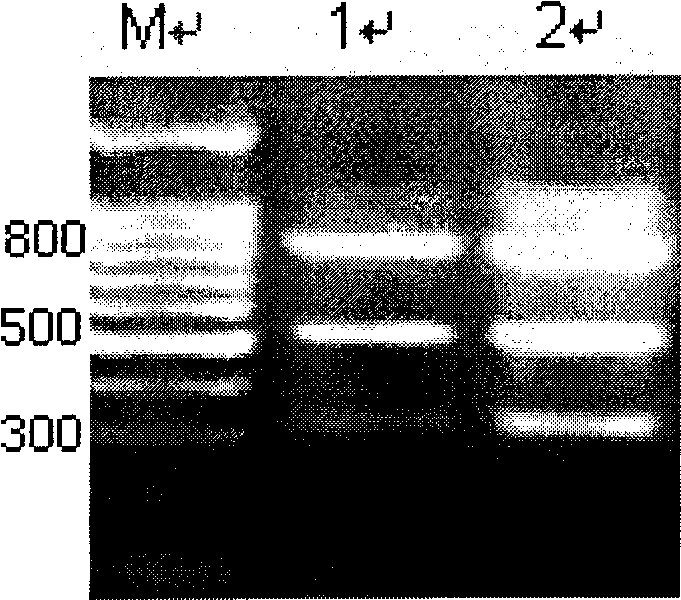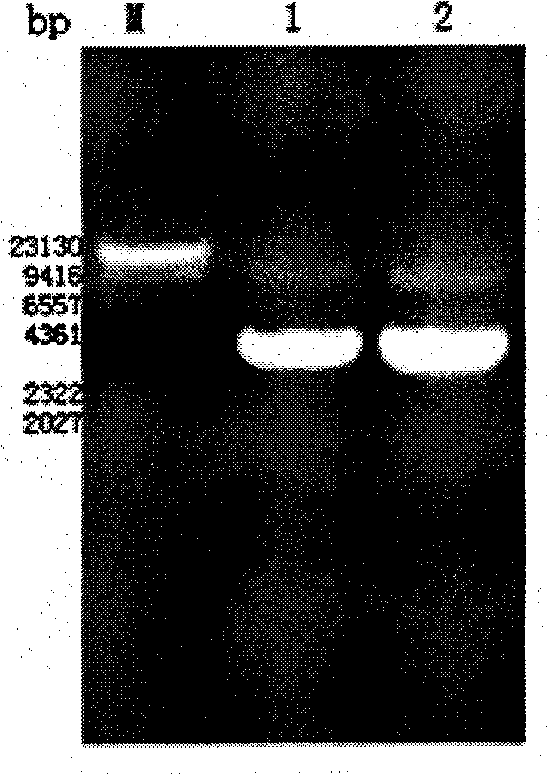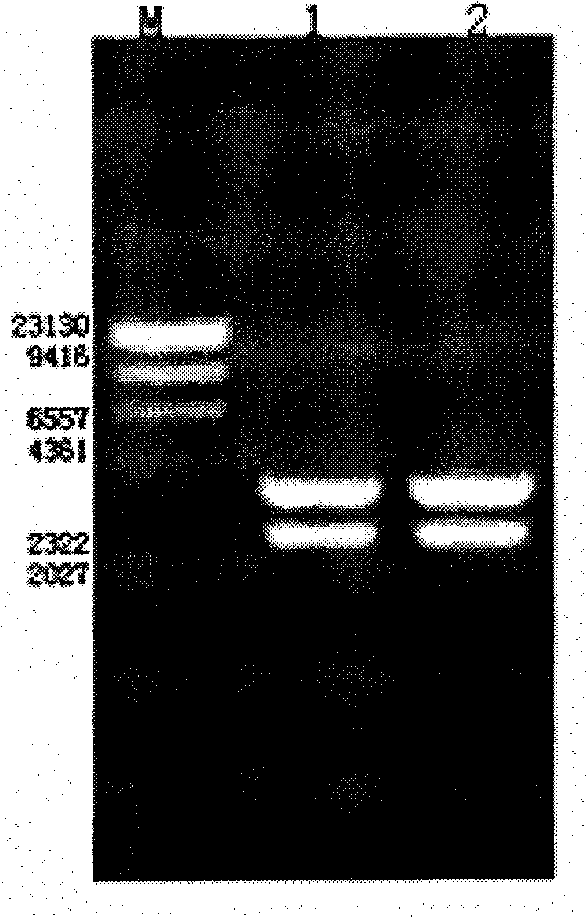Bt cryaAc22 gene with insecticidal activity for Lepidoptera insect and application thereof
A cry1ac22, gene technology, applied in the field of biological control, can solve problems such as the increase in the frequency of pest resistance, and achieve the effects of strong poisonous activity, reduced use, and reduced environmental protection
- Summary
- Abstract
- Description
- Claims
- Application Information
AI Technical Summary
Problems solved by technology
Method used
Image
Examples
Embodiment 1
[0065] Cry1Ac genotype analysis of strain WO15-1
[0066] 1) Total DNA extraction:
[0067] A single Bt colony was inoculated into 7mL LB liquid medium, cultivated overnight at 30℃, 220rpm, 1% transferred to a 250mL Erlenmeyer flask containing 50mL of LB medium, cultured at 30℃, 220rpm for 4 hours to OD600 =1.0~2.0; collect 10mL bacteria by centrifugation, wash the precipitate with 2mL JBuffer (0.1M Tris HCl (pH8.0), 0.1M EDTA (pH8.0), 0.15M Nacl); gently suspend the precipitate in 2mL JBuffer and add 80uL Freshly prepared lysozyme (50mg / mL), mix well and incubate at 37°C for 45min; add 15uLRNase (10mg / mL) and act at 50°C for 15min; then add 200μL SDS (20%) and treat at 70°C for 20min; cool slowly To 37℃, use equal volume of phenol: chloroform: isoamyl alcohol (25:24:1) and chloroform: isoamyl alcohol (24:1) to extract once, then add an equal volume of isoamyl alcohol and mix well and set at -20℃ The supernatant was precipitated for 20 minutes and centrifuged at 12,000 rpm for 10 ...
Embodiment 2
[0072] cry1Ac22 gene cloning
[0073] 1) WO15 plasmid DNA extraction:
[0074] Centrifuge to collect 10 mL of bacteria. Add 150uL SI (10% sucrose, 50mM Tris·Cl (pH 8.0), 20mM EDTA (pH 8.0) Lysozyme 20mg / ml, ready when used) for every 10mL of bacterial liquid, mix well, and bathe in 37℃ water for 3h; add 1350uL SII (10mM Tris·Cl, 1mM EDTA, 0.085MNaOH, 1.1% SDS when used), mix gently, let stand for 10 minutes, then add 750uL SIII (5M KAc, adjust to pH 4.8 with glacial acetic acid), invert the centrifuge tube upside down Mix gently, ice bath for more than 4 hours; centrifuge at 12,000 rpm for 10 minutes, take the supernatant, add 30RNase (10 mg / mL), let it act at 45°C for 30 minutes, add 1 / 10 volume of 3M NaAC and 2 times volume of absolute ethanol, -20°C Shen 30min. Centrifuge at 12,000 rpm for 10 min, discard the supernatant, and rinse the pellet with 70% ethanol. The precipitate was dried in a vacuum dryer and dissolved in 100uL ultrapure water. Take 5uL plasmid DNA sample on 0.8%...
Embodiment 3
[0080] Construction of engineering bacteria and induced expression, isolation and purification of its expression products
[0081] 1) Construction and identification of pQE30-Cry1Ac22 prokaryotic expression vector
[0082] According to the sequence of Bacillus thuringiensis Cry1Ac22, the primers for amplification of Cry1Ac22 were designed and synthesized. The amplified products were subjected to agarose gel electrophoresis, and the gel recovered products were ligated with pMD18-T vector. After transformation, the recombinant plasmid was extracted and digested with BamH I and Sal I. Identification, the digested fragment is 3500bp (such as image 3 Shown), consistent with the expected size, named HIC22 (pMD18-T-Cry1Ac22). The positive clones were sequenced and compared in GenBank after sequencing. The sequence was exactly the same as the Cry1Ac genotype.
[0083] The pMD18-T-Cry1Ac22 plasmid obtained above was digested with BamHI and SalI, and the target gene was recovered with a ge...
PUM
| Property | Measurement | Unit |
|---|---|---|
| molecular weight | aaaaa | aaaaa |
Abstract
Description
Claims
Application Information
 Login to View More
Login to View More - R&D
- Intellectual Property
- Life Sciences
- Materials
- Tech Scout
- Unparalleled Data Quality
- Higher Quality Content
- 60% Fewer Hallucinations
Browse by: Latest US Patents, China's latest patents, Technical Efficacy Thesaurus, Application Domain, Technology Topic, Popular Technical Reports.
© 2025 PatSnap. All rights reserved.Legal|Privacy policy|Modern Slavery Act Transparency Statement|Sitemap|About US| Contact US: help@patsnap.com



